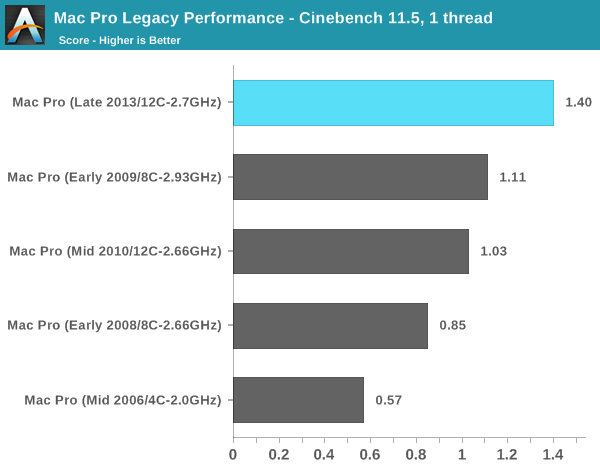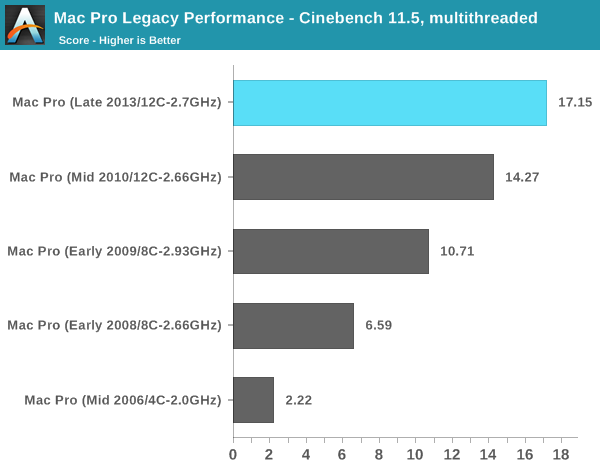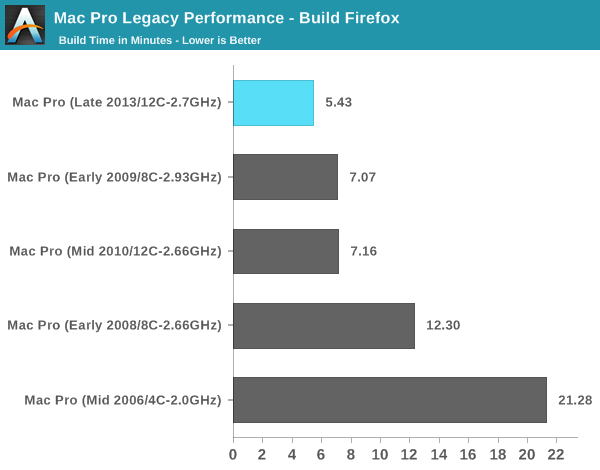The Mac Pro Review (Late 2013)
by Anand Lal Shimpi on December 31, 2013 3:18 PM ESTCPU Performance
I like to have large historical databases of performance so I can put new products in perspective. The Mac Pro and its funny lineage make this a little difficult. For starters, I simply haven't reviewed all of the Mac Pro CPU combinations that have existed over the years. Then there's also the fact that not all of my Mac suite applies well to a 12-core/24-thread Mac Pro. I'm going to try my best to put the new Mac Pro's performance in perspective, but it's going to require a couple of subsections.
Let's first start with a look at the historical performance of the Mac Pro. I really have to thank @elfurberino and @tapbot_paul for lending their time (and their Mac Pros) to help flesh out this comparison. With their help I managed to put together performance data for almost every single generation of Mac Pro.
We'll start with Cinebench R10's single threaded test. Unfortunately the benchmark crashes on Macs with 16+ threads so single threaded performance is all we'll be able to look at:

That's right, I still have my old PowerMac G5 Dual 2.5GHz (upgrade from my original 2.0 model). It's interesting to note that single threaded performance has only improved by 2.8x over that 2.5GHz dual G5 machine from around a decade ago. If we were able to also look at multithreaded performance we'd see a much larger gap. The dual G5's multithreaded performance is actually lower than the single threaded performance of the new Mac Pro's IVB-EP (3346 vs 5187). And the new Mac Pro has 12 of those cores.
Here you can see a very healthy increase in single threaded performance over the 2010/2012 12-core system. The 34% increase in performance is because the Mac Pro never got the Sandy Bridge bump. All previous Mac Pros topped out at Nehalem/Westmere. Couple all of the Sandy Bridge improvements with the much higher peak clock speeds (3.5GHz vs. 3.0GHz) and the performance gains make sense.
The 8C system from early 2009 gives us an example of how it's very possible to have a newer Mac Pro actually perform worse than its predecessor. Apple has done a relatively good job this round of keeping the core count/frequency tradeoffs sensible, but you still have to align your silicon choices to your workload.
Moving on to Cinebench 11.5, we lose the PowerMac G5 comparison but we gain a more modern benchmark. Once again we'll start with the single threaded numbers:

There's that healthy single threaded performance bump again. It is pretty incredible to me just how far we've come in single threaded performance since the mid-2000s. What's even crazier is that 2.0GHz Mac Pro from 2006 is only about 40% faster than a Bay Trail tablet with an Atom Z3770.

The multithreaded story is more evolutionary for sure, especially compared to the previous generation 12-core model. Here we're showing a 20% gain over the previous 12-core design. If you're migrating from a machine with fewer cores you can expect a corresponding increase in multithreaded performance. What is most surprising here is that a 2.3GHz 15-inch MacBook Pro with Retina Display (Late 2013) actually offers better multithreaded performance than the 8-core 2.66GHz Mac Pro from early 2008 in the chart above. The new 15-inch rMBP scores a 6.62 here compared to the 6.58 of that old Mac Pro.
I also shared my Firefox build test with Adam and Paul, who helped me fill out the chart below:

There isn't much of an advantage to having 12 cores here, but the new Mac Pro does deliver an amazingly quick build time compared to anything else. The new Mac Pro is good for around a 24% improvement in build performance compared to the outgoing 12-core model.










267 Comments
View All Comments
damianrobertjones - Thursday, January 2, 2014 - link
"I like the new Mac Pro’s chassis a lot. It’s a risk, but one that absolutely must be taken if the desktop is to continue to exist and thrive."Absolute rubbish... Sorry. We simply DO NOT have to change the case. Sure, of course, the option of having a case like this is fantastic but simply changing the case DOES NOT enable this to 'thrive'.
AnnonymousCoward - Sunday, January 5, 2014 - link
Agreedplatinumjsi - Thursday, January 2, 2014 - link
What are you using to monitor the GPU usage? I have been looking for a app for OSX for a while without any joy?hoboville - Thursday, January 2, 2014 - link
Sigh, lots of fanboyism in the comments, without recognition that this is just a slower, more expensive PC, the only difference is that it can run OSX only programs. Here's some hardware facts:This machine is basically a dual-GPU Xeon workstation with 2x 7970 in Crossfire (D700). Nothing special. Ok, so each 7970 has 6 GB of RAM. Well, each 7970 is also underclocked...and the RAM isn't ECC, so if you want one of these workstations for serious GPU compute, you're going to be eating bit errors, and your data is going to be suspect. Real GPGPUs use ECC RAM, period. If ECC doesn't matter, then dual/triple/quad AMD GPUs of any stripe will do you fine. Even better now that R9 290(X) are out, and they have 4 GB of RAM.
What if I need more local storage than 200 GB? Most raw video is bigger than that. So your files are stored on a NAS, but this machine only has gigabit NICs. If you want to take advantage of RAID throughput for massive files, you'll need 10 Gbit. But this machine can't use 10 Gbit NICs, as there's no place to put them.
This workstation, then, isn't for serious compute, those who have big files, and it isn't for those who want to use the most powerful GPUs for rendering / modeling. That belongs to Nvidia, there are plenty of benchmarks out there attesting to that fact. You can't get Nvidia on this workstation, so what then? I guess you buy this machine for Mac-specific applications.
And that's what this machine is for--Mac OS. If you want more power, UNIX/Linux/Windows boxes are where you go (not Apple-restricted Unix either). Are they bigger? Yes. Hotter? Yes. In fashion because small = sexy? Nope. And that's what this comes down to, looks, style, sleekness, and other metrics not relevant to performance. Sure, there's a niche for those who use Mac only software, but what if you want to do more? Apple has convinced people that style and a walled garden of software is more value than function, stop wasting your money and drop OSX!
pmhparis - Thursday, January 2, 2014 - link
Snort, the ignorant NVidia hobo fanboy complains of Mac fanboys...Professionals don't store video projects on internal storage, they use DAS devices like Thunderbolt or USB3 disk enclosures.
Houston1 - Thursday, January 2, 2014 - link
Incorrect.Chirpie - Friday, January 3, 2014 - link
No, it's pretty spot on. Every video environment I've worked in does not keep the project files and assets on the machine. It's a very normal/typical way of doing business with many terabytes worth of files. I'll go one step further though and say that it's not just USB and Thunderbolt but even duplexed gigabit ethernet or optical, or a number of other flavors as well.FunBunny2 - Saturday, January 4, 2014 - link
Steve was always the best snake oil salesman since Barnum. How Apple can contend that it spends billions and billions of dollars on R&D is baffling. It can't have cost that much to devise a square cornered rectangle, or single cornered Cube. The parts, 99.44% are off the shelf from suppliers.DotFab - Thursday, January 2, 2014 - link
Many thanks for this impressive review of the MacPro 2013!!You treat every point and more I had in mind!
A huge and fine work, I really feel like I know what's the MP 2013 now.
Happy new year to AnandTech and to everyone !
HisDivineOrder - Thursday, January 2, 2014 - link
I love that Anand is discussing his well-known Apple addiction and the subsequent fanboyism he engages in. It is good. Admitting he has a problem means he can perhaps one day overcome it.One day. Today is not the day.
How can anyone in their right mind suggest buying such a limited-expandability computer for anything NOT a low-power HTPC? If you pay this much money, you really ought to be able to easily change out the GPU(s).
When you're so hooked on a company's products you're rubbing them like Gollum rubbing the Ring of Power, I think you've got to stop and take stock.